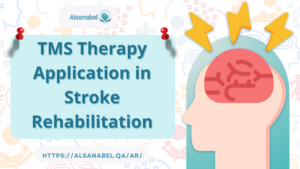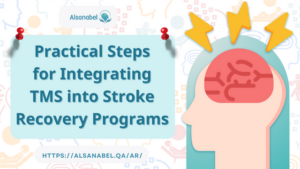The Effectiveness of TMS Therapy in Stroke Rehabilitation 2024
- Category TMS sessions
The effectiveness of TMS therapy in stroke rehabilitation is a topic of growing interest and research. As studies continue to explore the impact of rTMS on various facets of stroke recovery, it becomes crucial to analyze the existing evidence to determine its efficacy. This review delves into the current literature on rTMS applied to different clinical and rehabilitative aspects of stroke patients, shedding light on the potential benefits and challenges associated with this innovative therapy.
TMS Therapy Application in Stroke Rehabilitation
Transcranial Magnetic Stimulation (TMS) therapy is a non-invasive method that employs magnetic fields to activate nerve cells in the brain. Although commonly used for depression and certain neurological conditions, its potential in stroke recovery is gaining attention.

- Motor Recovery: TMS can adjust brain activity in the affected hemisphere post-stroke, targeting motor areas to enhance movement and aid in recovery.
- Cognitive Rehabilitation: Stroke often leads to cognitive issues like attention deficits; TMS can stimulate relevant brain regions to improve cognitive function.
- Language Rehabilitation: TMS can target language areas in the brain to aid in language recovery for stroke survivors with aphasia, improving speech production and comprehension.
- Swallowing Rehabilitation: TMS can target areas related to swallowing to enhance function and aid in dysphagia rehabilitation.
- Functional Electrical Stimulation (FES) Enhancement: Combining TMS with FES can promote motor recovery by inducing plasticity and facilitating motor relearning.
- Modulation of Neuroplasticity: TMS can induce changes in cortical excitability and promote neuroplasticity, vital for brain reorganization after stroke.
Benefits of TMS Therapy in Stroke Recovery
TMS sessions holds promise for stroke recovery in several ways:
- Motor Function Improvement: TMS can target the motor cortex, aiding in muscle strength, coordination, and movement control restoration.
- Neuroplasticity Enhancement: By inducing neuroplastic changes, TMS helps the brain reorganize neural networks, facilitating functional recovery.
- Facilitation of Cortical Reorganization: TMS modulates cortical excitability, promoting brain reorganization and compensatory pathways recruitment.
- Reduction of Spasticity: TMS therapy may alleviate spasticity by modulating motor neuron excitability and inhibiting abnormal muscle activity.
- Enhancement of Functional Outcomes: TMS, combined with standard rehabilitation, leads to improved motor control, independence, and quality of life.
- Non-Invasive Brain Stimulation: Being non-invasive and well-tolerated, TMS treatment is a safe alternative, suitable for stroke rehabilitation.
- Versatility in Treatment Approaches: TMS can target specific brain regions, offering flexibility to customize therapy according to individual needs.
- Promotion of Long-Term Recovery: By inducing enduring changes in brain function, TMS may sustain motor and cognitive improvements over time.
Despite its potential, further research is needed to determine efficacy, optimal parameters, and long-term effects. Individualized treatment plans are crucial for maximizing benefits in stroke survivors.
Mechanisms of TMS Therapy in Stroke Rehabilitation
Transcranial Magnetic Stimulation (TMS) therapy affects stroke rehabilitation through various mechanisms:
- Modulation of Cortical Excitability: TMS normalizes abnormal cortical excitability patterns post-stroke, restoring the balance between inhibitory and excitatory neurotransmission.
- Neuroplasticity Induction: By inducing neuroplastic changes, TMS promotes the reorganization of neural circuits, facilitating the restoration of function in damaged areas.
- Enhancement of Synaptic Efficacy: TMS strengthens synaptic connections, improving motor function, coordination, and control.
- Facilitation of Long-Term Potentiation (LTP) and Long-Term Depression (LTD): TMS induces LTP-like and LTD-like effects, aiding in motor skill consolidation and new behavior acquisition.
- Rebalancing of Interhemispheric Inhibition: TMS rebalances interhemispheric inhibition, leading to improved motor function in the affected limb.
- Modulation of Neurotransmitter Systems: TMS influences neurotransmitter release and activity, enhancing synaptic transmission and neural plasticity mechanisms.
- Reduction of Inflammation and Oxidative Stress: TMS exhibits anti-inflammatory and neuroprotective effects, fostering a favorable environment for neuronal repair post-stroke.
- Integration with Rehabilitation Interventions: TMS can be combined with other therapies to maximize therapeutic effects in stroke rehabilitation programs.
These mechanisms collectively contribute to the efficacy of TMS therapy in promoting recovery and functional improvement following stroke.
Safety and Considerations of TMS Therapy in Stroke Patients
Safety considerations are paramount when utilizing TMS sessions in stroke rehabilitation:
- Seizure Risk: Individuals with a history of epilepsy or seizures require careful screening, as TMS may trigger seizures.
- Safety Guidelines: Adherence to established safety protocols is crucial, including determining appropriate stimulation parameters and implementing monitoring measures for adverse effects.
- Location of Stimulation: Stimulation sites must avoid areas prone to adverse effects, focusing on regions relevant to motor or cognitive recovery.
- Monitoring for Adverse Effects: Close observation for adverse reactions, especially in vulnerable stroke patients, is imperative during and post-TMS sessions.
- Individualized Treatment Plans: Customized plans, considering stroke severity, lesion location, and medical history, ensure TMS appropriateness and safety.
- Contraindications and Precautions: Conditions such as implanted medical devices and heightened seizure risk necessitate caution or contraindicate TMS.
- Multidisciplinary Approach: Integration into a comprehensive stroke rehabilitation program involving various specialists optimizes safety and efficacy.
- Informed Consent: Clear communication regarding risks, benefits, and alternatives ensures informed decision-making by patients and caregivers.
Practical Steps for Integrating TMS into Stroke Recovery Programs
Integrating Transcranial Magnetic Stimulation (TMS) into stroke recovery programs involves several crucial steps to ensure safe and effective implementation. Here’s a comprehensive guide:

- Assessment and Screening: Conduct a thorough neurological assessment to evaluate motor function, cognitive abilities, and language skills, Screen for contraindications to TMS therapy, such as seizure history or implanted medical devices.
- Goal Setting: Establish clear rehabilitation goals tailored to the individual needs and deficits of the stroke patient, Define specific outcomes TMS therapy aims to address and improve, whether motor, cognitive, or language-related.
- Treatment Planning: Develop an individualized treatment plan that combines TMS with other rehabilitation interventions like physical therapy and speech therapy, Determine the timing, frequency, and duration of TMS sessions based on clinical status and treatment objectives.
- Stimulation Protocol: Set stimulation parameters including intensity, frequency, duration, and target sites based on treatment goals and patient characteristics, Consider using neuronavigation or neuroimaging to precisely target relevant cortical areas.
- Safety Precautions: Implement safety measures such as seizure monitoring, equipment checks, and trained staff supervision during TMS sessions, Educate patients and caregivers about potential side effects and reporting procedures.
- Session Delivery: Administer TMS in a controlled clinical setting by trained healthcare professionals, Monitor patient response to TMS and adjust parameters as necessary.
- Outcome Assessment: Evaluate TMS effectiveness through standardized assessments, functional tests, and patient-reported outcomes, Monitor longitudinal changes in motor function, cognition, and quality of life post-TMS.
- Interdisciplinary Collaboration: Foster collaboration among rehabilitation team members to ensure coordinated care and communication, Involve physicians, therapists, nurses, and TMS specialists in treatment planning and delivery.
- Patient Education and Support: Educate patients and caregivers about TMS therapy, its benefits, and what to expect during treatment, Provide ongoing support and counseling to address concerns and questions.
- Documentation and Follow-Up: Maintain detailed records of TMS sessions and patient responses, Schedule regular follow-up appointments to assess progress, adjust treatment plans, and address new goals or challenges.
Thank you for taking the time to learn more about the effectiveness of TMS therapy in stroke rehabilitation. I hope this information has been helpful and informative to you. If you have any questions or would like to share your thoughts on this topic, please feel free to leave a comment below. Keep staying informed and empowered in your journey towards stroke recovery.









